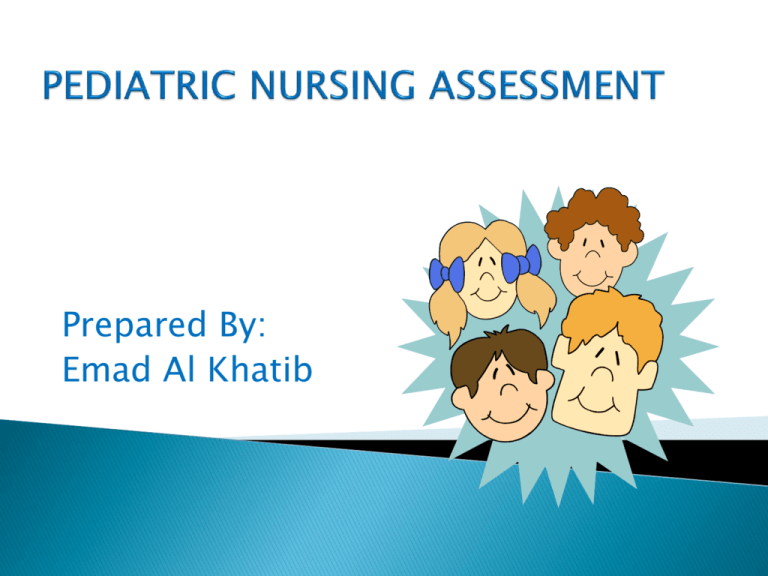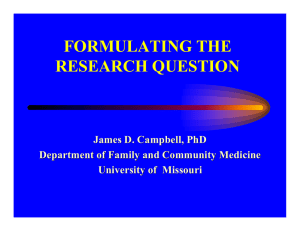PEDIATRIC NURSING ASSESSMENT
advertisement

Prepared By: Emad Al Khatib Oxygenation, ventilation adequate to preserve life, CNS function? Cardiac output sufficient to sustain life, CNS function? C-spine protected? Major fractures immobilized? If invasive procedure considered, do benefits outweigh risks? If parent is not accompanying child, is history adequate? Reassess, Reassess, Reassess A. Name: Age: Sex: Time of Arrival to Unit: Mode of Admission Mother’s Name: Occupation: Age: Address: Father’s Name: Occupation: Age: Address: B ) Brief, relevant ◦ ◦ ◦ ◦ ◦ ◦ Specifics of present illness Allergies Medications Past medical history Last oral intake Events leading to call C. Chief Concern (Narrative of Present Illness) D Wt: Ht: Temp:____ (oral,axilla,rectal) Pulse__ ___ (regular/irregular) Resp_____ (regular/irregular) BP E. Past History 1. Birth History a. Mother’s health during pregnancy b. Labor and delivery c. Infant’s condition immediately after birth (APGAR) F. Functional Health Pattern Assessment : 1) Why has your child been admitted? 2) How has your child’s general health been? 3) Has your child ever been in the hospital before? What things were important to you and Your child during that hospitalization? How can we be most helpful now? What medications does your child take at home? Why are they given? When are they given? How are they given (if a liquid, with a spoon, if a tablet, swallowed with water or other)? Does he have any allergies to medications. H. Physical Assessment 1) INTEGUMENTARY system: Intact, hygiene, rashes, abrasions . ** Capillary refill: - Check base of thumb or heel. - Normal< 2 second. - Increase suggest poor perfusion. - Cold exposure may falsely elevate time. 2) EENT Eyes – pale, conjuctiva, Ears – hearing, symmetry, discharge, pain Nose – epistaxis, stuffy nose Throat – dental condition, tonsillitis Mouth – mouth breathing, gum bleeding 3) NECK – pain, limitation of movement 4) CHEST – breast enlargement, masses 5) RESPIRATORY – chronic cough, frequent colds (#/yr) 6) CARDIOVASCULAR – cyanosis, fatigue on exertion, anemia, blood type, CBC, rate and rhythm of heart. 7) UT – frequency, dysuria, 8) GIT – food intolerance, eating and elimination habits, vomiting 9) MUSCULOSKELETAL – weakness, lack of coordination, abnormal gait, deformities, fractures 10) NEUROLOGICAL – fontanels, head circumference, orientation to time place and alertness, responsiveness to reflexes. Perform physical examination from head to toe on a pediatric patient. You may need to alter the order of the examination for patient compliance for uncooperative or hyperactive patients. Do not force a child to do something that may be frightening or uncomfortable to them. When examining an infant, toddler, or school-aged child it is suggested to have a parent or guardian in the room with you. With an adolescent, it may be more appropriate not to have the parent in the room with you, this may allow the patient to feel that they can be more relax. Vital signs in pediatrics include temperature, heart rate, blood pressure, respiratory rate, weight, length, and head circumference. The shape and position of the eyes should be noted. Any abnormal eye movement and the ability to focus on the examiner are important to note. Hard to examine because of the bright lights. Look for deformities, obstruction of the airway, color of the mucosa, discharge, and tenderness. Check the nose for foreign bodies (beans, carrots) younger children often putting foreign objects into the various orifices of the body and they often get stuck their. A green, foul smelling, purulent discharge from only one side of the nose is common with a foreign object being left in the nose. Purulent discharge bilaterally indicates infection. Delivery can give nasal obstruction due to displacement of the septal cartilage. Flaring of the nostril almost always shows respiratory distress. Mucosal Assessment: ◦ Red: Acute infection ◦ Blue and Boggy: Allergy ◦ Gray and Swollen: Rhinitis Frontal sinus developed by 5 years of age. The size and any aberration in shape of the external ear (Pinna) should be noted. A low position (below the level of the eyes) may be an indication of a brain defect (down syndrome). Inspection of the ear can be done by checking the 4 D’s: ◦ ◦ ◦ ◦ Discharge Discoloration Deformity Displacement Discharge: from the ear canal can be a result of otitis external or chronic untreated otitis media. To differentiate between otitis externa and otitis media, pull on the pinna, if this elicits pain, it is most likely otitis externa. Discoloration in the form of eccymosis over the mastoid area is called “Battle Sign”, and is associated with trauma and should be considered an emergency. Examine the external mouth for symmetry, such as drooping of the corner of the mouth. The lips and mucous membrane should be examined for evidence of cyanosis. The soft palate should be examined for presence of the gag reflex, evaluates the vagus nerve. The quality of the patient’s voice should also be noted. The tongue should be examined for size, shape, color, and coating. ◦ A strawberry tongue is seen in specific stages of Scarlet Fever. ◦ A geographic tongue is a common finding.









